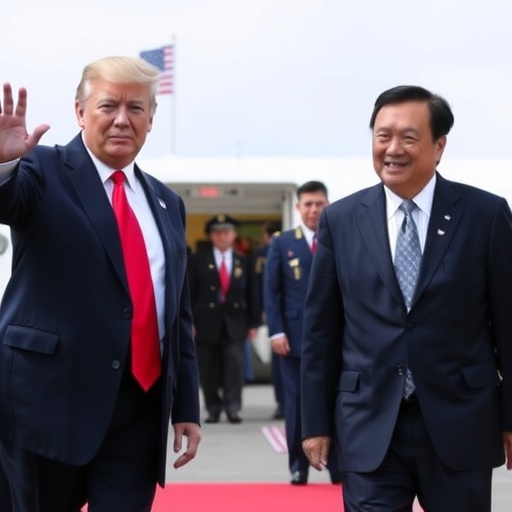Trump Launches Three-Day Japan Visit to Strengthen U.S.-Japan Alliance Amid Regional Tensions with PM Takaichi
In a move that underscores America’s renewed focus on the Asia-Pacific, President Donald Trump is poised to touch down in Tokyo today, marking his first official overseas trip since reclaiming the White House in his second term. The three-day visit, centered on high-stakes talks with Japan’s newly appointed Prime Minister Sanae Takaichi, aims to fortify the U.S.-Japan alliance against escalating threats from North Korea’s missile tests and China’s assertive maneuvers in the South China Sea. As global markets watch closely, this summit could redefine bilateral ties in an era of geopolitical flux.
Trump‘s Tokyo Arrival: A Symbol of Enduring Partnership
President Trump’s arrival at Haneda International Airport is scheduled for early afternoon local time, where he will be greeted by a high-level delegation led by Prime Minister Takaichi herself—a gesture signaling the warmth and urgency of the bilateral relationship. This visit comes just weeks after Trump’s inauguration, highlighting Japan’s priority status in his foreign policy playbook. Sources close to the White House indicate that the itinerary includes a state dinner at the Imperial Palace, bilateral meetings at the Prime Minister’s Office, and a joint press conference, all designed to project unity.
The U.S.-Japan alliance, forged in the aftermath of World War II and enshrined in the 1960 Treaty of Mutual Cooperation and Security, has evolved into a cornerstone of regional stability. Under Trump’s first term, the partnership saw expansions in defense cooperation, including joint exercises and intelligence sharing. Now, with Takaichi at the helm—Japan’s first female prime minister in nearly two decades—observers anticipate a fresh dynamic. Takaichi, a conservative stalwart known for her hawkish views on national security, has already voiced her intent to “deepen the unbreakable bond” with the United States.
Historical precedents abound: Trump’s 2017 visit to Japan included a now-iconic golf outing with then-Prime Minister Shinzo Abe, which humanized the alliance amid trade negotiations. This time, the focus shifts squarely to security, though economic undercurrents remain. According to a recent poll by the Pew Research Center, 78% of Americans view Japan favorably, up from 68% in 2019, reflecting broad public support for closer ties.
As Air Force One descends, security protocols are at an all-time high. Tokyo’s streets are lined with American and Japanese flags, and local media buzz with excitement. One Japanese analyst remarked to NHK, “This summit isn’t just diplomacy; it’s a statement to Beijing and Pyongyang that the alliance is ironclad.”
Takaichi’s Rise and Vision for U.S.-Japan Synergy
Prime Minister Sanae Takaichi’s ascent to power earlier this year, following a snap election, has injected new energy into Japan’s political landscape. A protégé of the late Shinzo Abe, Takaichi brings a blend of economic nationalism and security realism to the role. Her appointment as prime minister in a coalition government marks a pivotal shift, especially as she navigates domestic challenges like an aging population and stagnating growth while eyeing stronger ties with Trump.
During the summit, discussions will likely center on enhancing the U.S.-Japan alliance through upgraded defense pacts. Japan, bound by its pacifist constitution, has increasingly leaned on U.S. forces stationed in Okinawa—home to over 50,000 American troops. Recent data from the U.S. Department of Defense shows that joint military drills have surged by 40% since 2020, with exercises simulating responses to hypothetical invasions of Taiwan or the Senkaku Islands.
Takaichi’s agenda includes pushing for more equitable burden-sharing in the alliance. In a pre-visit op-ed in The Wall Street Journal, she wrote, “The U.S.-Japan partnership must adapt to 21st-century threats. Together, we can ensure a free and open Indo-Pacific.” Trump, known for his “America First” doctrine, has signaled openness to this, tweeting last week: “Japan is a great ally—time to make our deal even stronger!”
Behind the scenes, advisors from both sides are aligning on specifics. A senior U.S. official, speaking anonymously to Reuters, revealed that talks will address increasing Japan’s defense spending, which Takaichi aims to raise to 2% of GDP by 2027—up from 1% currently. This aligns with Trump’s past calls for allies to pay more for U.S. protection, potentially averting frictions seen in his first term.
The personal chemistry between Trump and Takaichi could prove decisive. Both leaders share a penchant for bold rhetoric and skepticism toward multilateral institutions like the UN. Analysts at the Brookings Institution predict that this rapport might yield breakthroughs in areas like cybersecurity, where Japan and the U.S. face common vulnerabilities from state-sponsored hacks.
Navigating Regional Threats: North Korea and China in the Spotlight
No U.S.-Japan summit would be complete without addressing the powder keg of regional security. North Korea’s barrage of ballistic missile launches—over 90 in 2023 alone, per South Korean intelligence—has heightened alarms. During Trump’s visit, expect robust exchanges on denuclearization strategies, building on his 2018-2019 summits with Kim Jong Un.
China’s growing assertiveness looms larger. Beijing’s claims over the East China Sea, including disputed territories near Japan, have led to frequent naval standoffs. The U.S. Navy’s freedom-of-navigation operations through the Taiwan Strait have irked China, prompting retaliatory rhetoric. A 2023 RAND Corporation report estimates that a conflict over Taiwan could cost the global economy $2.6 trillion, underscoring the stakes for the U.S.-Japan alliance.
Takaichi has been vocal about these perils. In a speech to the Diet last month, she declared, “We cannot afford complacency. The alliance with America is our shield against aggression.” Trump, in turn, has lambasted China on trade and security fronts, imposing tariffs that indirectly bolster Japan’s position as a reliable U.S. partner.
Practical measures under discussion include expanding the QUAD framework—comprising the U.S., Japan, Australia, and India—with more joint patrols. Statistics from the International Institute for Strategic Studies show that China’s military budget has ballooned to $292 billion in 2023, dwarfing Japan’s $46 billion, making allied coordination essential.
Environmental security also factors in, with climate change exacerbating typhoons and sea-level rise in the Pacific. The summit may touch on collaborative disaster response, drawing from lessons of the 2011 Fukushima crisis where U.S. aid was pivotal.
Economic Pillars: Trade Deals and Tech Collaboration on Deck
Beyond security, the Trump-Takaichi summit will tackle economic interdependence, a bedrock of the U.S.-Japan relationship. Bilateral trade topped $300 billion in 2023, according to U.S. Census Bureau figures, with Japan as America’s fourth-largest trading partner. Trump’s first-term renegotiation of the U.S.-Japan Trade Agreement reduced agricultural tariffs, benefiting American farmers, but lingering issues like auto exports persist.
Takaichi seeks to mitigate supply chain vulnerabilities exposed by the COVID-19 pandemic and recent chip shortages. Discussions may advance the U.S.-Japan Critical Minerals Agreement, aiming to secure rare earths away from Chinese dominance. Japan, a leader in semiconductors, could partner with U.S. firms like Intel under the CHIPS Act, which allocates $52 billion for domestic production.
Quotes from business leaders highlight optimism. Toyota CEO Akio Toyoda stated in a Nikkei interview, “This summit could unlock innovations that benefit both economies.” Trump has teased potential incentives, saying at a recent cabinet meeting, “Japan makes fantastic cars—we’ll work on fair trade that helps American workers too.”
Investment flows are another focus: Japanese firms have invested over $700 billion in the U.S. since 1951, creating 900,000 jobs. The visit includes a roundtable with CEOs from Boeing and Sony, exploring green tech and AI collaborations. With inflation cooling in both nations—U.S. at 3.1% and Japan at 2.5% per latest CPI data—the timing is ripe for deals that spur growth.
Cultural exchanges add a softer edge. The itinerary features a visit to a sumo tournament and cherry blossom viewing if weather permits, reminding all of the people-to-people ties that underpin policy.
Global Ripples: What the Summit Means for Asia and Beyond
As the three-day visit unfolds, its outcomes could reverberate across the Indo-Pacific and into global forums. A strengthened U.S.-Japan alliance might embolden responses to Russian incursions in Ukraine, given Japan’s sanctions support. NATO Secretary-General Jens Stoltenberg has praised the partnership as a “model for transatlantic-Pacific cooperation.”
Looking ahead, the summit lays groundwork for Trump’s broader Asia tour, potentially including stops in South Korea and India. Success here could ease domestic pressures on Takaichi, whose approval ratings hover at 55% amid economic reforms. For Trump, a productive engagement burnishes his image as a dealmaker, crucial with midterms looming.
Challenges remain: Public protests in Okinawa over U.S. bases could cast shadows, and any perceived concessions to Japan on trade might irk Trump’s base. Yet, the consensus among experts is positive. The Council on Foreign Relations’ Sheila Smith noted, “This is a pivotal moment to reaffirm commitments before tensions escalate.”
In the days post-summit, joint statements are expected to outline actionable steps—perhaps a new defense roadmap or trade pacts—signaling stability to investors. As Trump departs Tokyo, the world will gauge whether this visit truly fortifies the alliance against an uncertain horizon, ensuring peace through strength in a volatile region.








